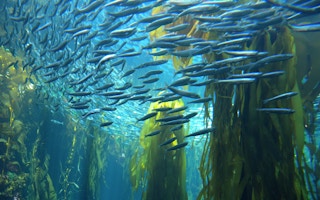Even as large underwater forests of kelp, brown marine algae seaweeds, are declining by roughly 1.8 per cent annually, there is little information on how local conditions impact their response to global stress factors.
“We need to understand how local environmental conditions and drivers of change affect the resistance and recovery of kelp to global stressors,” Danielle Denley, a postdoctoral fellow at the Pacific Institute for Climate Solutions, said at the fifth International Marine Protected Areas Congress.
Kelps cover 25 per cent of the world’s coastlines and provide food and shelter for fish, invertebrates and marine mammal species. They also offer crucial services such as carbon sequestration and erosion control, according to scientists.
But kelps are increasingly threatened by climate change, eutrophication and shoreline development, among other human-induced stressors.
One such threat is from bryozoa, moss animals that grow as mats on kelps. They drive the seaweed to sink into the seafloor and disintegrate.
The outbreak can be linked to high temperatures. For example, in 2015, researchers observed an expansive outbreak of bryozoa. These observations coincided with ‘the blob’, a marine heat wave that emerged across the northeast Pacific Ocean, according to a report.
Denley and her team looked at how environmental and biological variables influence the amount of bryozoan on giant kelp. They found that high temperature and kelp density resulted in more bryozoan, while high wave exposure had the opposite effect.
“
You can’t have a blue economy unless you have the involvement and consent of indigenous people.
Judith Sayers, chancellor, Vancouver Island University
Dense kelp beds in warmer and less wave-exposed sites are more susceptible to bryozoan outbreaks, Denley noted. The researcher hopes to study how harvesting kelps impact their density, seawater temperature, water flow and bryozoan cover.
Denley called for collaborative research driven by the needs and priorities of local communities.
Seaweed and indigenous communities
Seaweeds are farmed as they have industrial applications. They can be harvested to extract biostimulants for plant growth. They also can help in long-term carbon sequestration and regeneration of ocean habitats.
Further, seaweed is thought to store around 175 million tonnes of carbon annually, raising hopes of using the macroalgae to fight climate change.
However, a 2022 study found that seaweed may not mitigate carbon dioxide emissions.
Seaweeds could play an essential role in the blue economy, which according to the World Bank, is the sustainable use of ocean resources for economic growth, improved livelihoods and jobs while preserving the ocean’s health.
“You can’t have a blue economy unless you have the involvement and consent of indigenous people,” Cloy-e-iis, Judith Sayers, president of the Nuu-chah-nulth Tribal Council and Chancellor of Vancouver Island University, said at the Congress.
Some of Canada’s practices harm sustainable development. These include licensing oil pipelines, low environmental standards for cruise ships and overfishing, she said.
Indigenous knowledge and science should be applied to deeply understand nature and its potential to thrive, stressed David Parker, chief executive and co-founder of Ocean Regenerative, a seaweed (marine algae) farming enterprise.
This story was originally published on Down to Earth.










